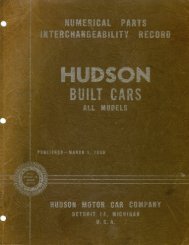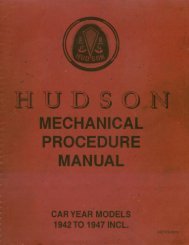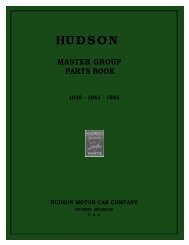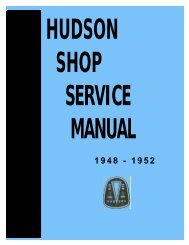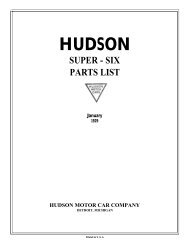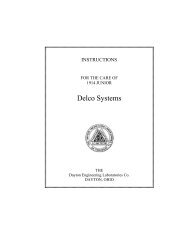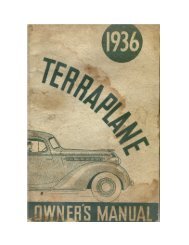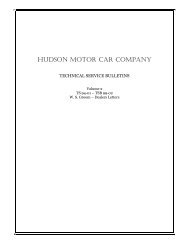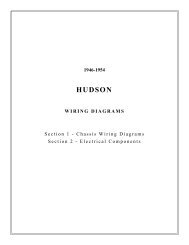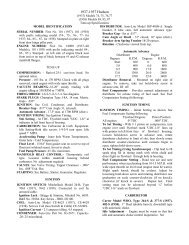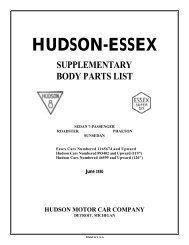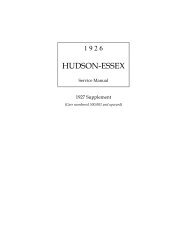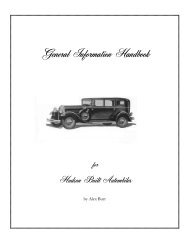The General Information Handbook for Hudson Automobiles by Alex ...
The General Information Handbook for Hudson Automobiles by Alex ...
The General Information Handbook for Hudson Automobiles by Alex ...
Create successful ePaper yourself
Turn your PDF publications into a flip-book with our unique Google optimized e-Paper software.
Beginning in 1935 <strong>Hudson</strong> used a numerical system <strong>for</strong> identifying Models. <strong>The</strong> first number denoted the year, the second<br />
the actual series (or model). A car with '53' at the beginning of the serial number would be a 1935 ('5') <strong>Hudson</strong> Six ('3'). <strong>The</strong><br />
remaining digits denote the actual serial number.<br />
In addition, during the 1930's cars built in <strong>Hudson</strong> Canadian plants were identified with the insertion of the letter ‘C’<br />
between the model/series designator and the actual serial number. Thus a car carrying the serial number ‘62C14133’ would be<br />
a 1936 (‘6’) Terraplane Model 62 Custom (‘2’) built in Canada (‘C’).<br />
This system was used until 1950 with the following variations:<br />
a). 1940 Models used the numeral '4' to denote the Year; ie, Model 41, 44, etc;<br />
b). 1946 Models used the numeral '3’ to denote the Year in the serial number, ie, 32 - but used the numeral '5' <strong>for</strong> the<br />
Model designation as in 51 (1946 Super Six).<br />
c) 1947 Models used the numeral '17’;<br />
d) 1948 used the numerals '48';<br />
e) 1949 used the numerals '49';<br />
f) 1950 used the numerals '50' except <strong>for</strong> the Model 50A Pacemaker<br />
In the 1948 through 1950 Models a 3rd number was used to designate the Model; thus a Model 481 would be a 1948 ('48')<br />
Super Six ('1’); a Model 503 would be a 1950 Super 8. (See individual year sheets <strong>for</strong> other numbers).<br />
From 1951 through 1954 a numeric/alpha system was used with 'A' assigned to 1951, 'B' to 1952, 'C' to 1953 and “D” to<br />
1954. A Model '5B' would be a 1952 Wasp while a Model '7C' would be a 1953 Hornet. <strong>The</strong>re were a few 1953 Model '8C'<br />
Commodore 8 cars produced, being left over 1952 Commodore 8's with 1953 grilles, trim and ID plates.<br />
< Abbreviations ><br />
AC - manufacturer<br />
Limo - Limousine<br />
auto - automatic<br />
n/a - Data not available<br />
BT - Boat-tail (as in boat-tail speedster) Pass - Passenger (also p)<br />
CC - Country Club (late 30's - early 40's)<br />
RHD - Right Hand Drive (also rhd)<br />
Cvt - Convertible (also CV, Convt)<br />
RS - Rumble seat<br />
DC - Dual Cowl (as in Dual Cowl Phaeton)<br />
S/N - Serial Number (also s/n)<br />
exc - except<br />
Sed - Sedan (also sd)<br />
FP - Factory Price (also fp)<br />
ST - Standard Transmission<br />
HT - Hydramatic Transmission (also hyd)<br />
TC - Town Car (also TwnCr)<br />
LHD - Left Hand Drive (also lhd)<br />
Tr - Touring (also Trg)<br />
LimoTwnCr - Limousine Town Car<br />
unk - unknown<br />
3) Other Notes:<br />
a) Starter/Generator - In the 1916-1922 period <strong>Hudson</strong>, among others, used a 'starter/generator’ unit. This device,<br />
connected to a storage battery, functioned as a starter to start the motor, and then became a generator once the engine was<br />
running.<br />
b) See Don Butlers "History of <strong>Hudson</strong>" <strong>for</strong> explanation of 1st and 2nd series Models through the 1920's into the<br />
1930's.<br />
< Explanation of Some Body Styles ><br />
Brougham<br />
Two-Door Sedan (2-Dr. Sed)<br />
Two-Door Coupe (2-Dr. Cpe)<br />
Utility Coupe (UtCpe)<br />
Victoria Coupe (VicCpe)<br />
Business Coupe (BusCpe)<br />
Club Coupe (ClCpe)<br />
Utility Coach (UtCh)<br />
Hollywood (Hlwd)<br />
- two door sedan<br />
- long roof line similar to a 4-door sedan<br />
- shortened roof line and longer rear deck<br />
- coupe with a sliding pickup box in the trunk (I 930's)<br />
- Coupe with one or two fold-down jump seat behind front seat (I 930's)<br />
- coupe with no rear seat and a package shelf behind front seat<br />
- coupe with a full passenger seat close behind the front seat<br />
- brougham (2-dr) with removable rear seat to provide cargo space<br />
- 2-door hardtop with no center pillar (1950's)<br />
iii



